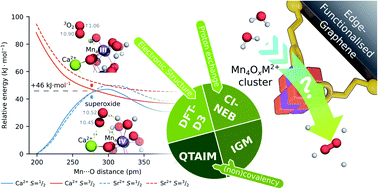Towards a computational understanding of water oxidation at graphene-bound MnxOy and MnxOyM2+ particles
Abstract
The coordination of oxo-manganese clusters to edge-functionalised graphene (EFG) offers a potential route to advanced water oxidation electrodes with exceptional electrochemical surface area and electron transport properties. Prior work has demonstrated the feasibility of edge-coordination of a variety of oxo-manganese clusters to graphene sheets under a range of graphene-consistent ligand constraints (GCLCs) (Terrett, et al. 2021). Here, a broken-symmetry Density Functional Theory (DFT) and Quantum Theory of Atoms in Molecules (QTAIM) approach is employed to investigate the ability of one such cluster to support reactive intermediates of potential relevance to water oxidation. These calculations demonstrate that the cluster is capable of supporting a range of coordination geometries, radical states, and reactions of relevance to water oxidation. Particularly, coordination of Ca2+ and Sr2+ is shown to reduce the activation energy of dioxygen release from the cluster within a scenario of superoxide radical oxidation, suggesting a potential mechanism for catalytic enhancement. The cluster supports a highly labile first coordination sphere of aqua and hydroxo ligands, the facile proton exchange energetics of which are characterised in detail using a Climbing Image Nudged Elastic Band (CI-NEB) approach. Group II metal adducts of the cluster bear striking structural and functional similarities to the oxygen-evolving centre (OEC) of Photosystem II (PSII).



 Please wait while we load your content...
Please wait while we load your content...